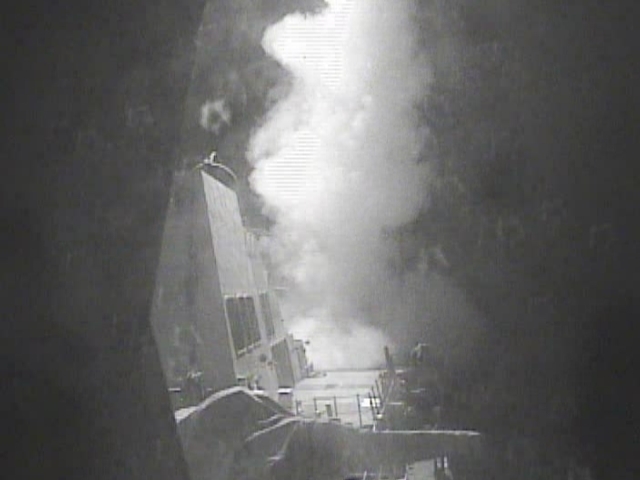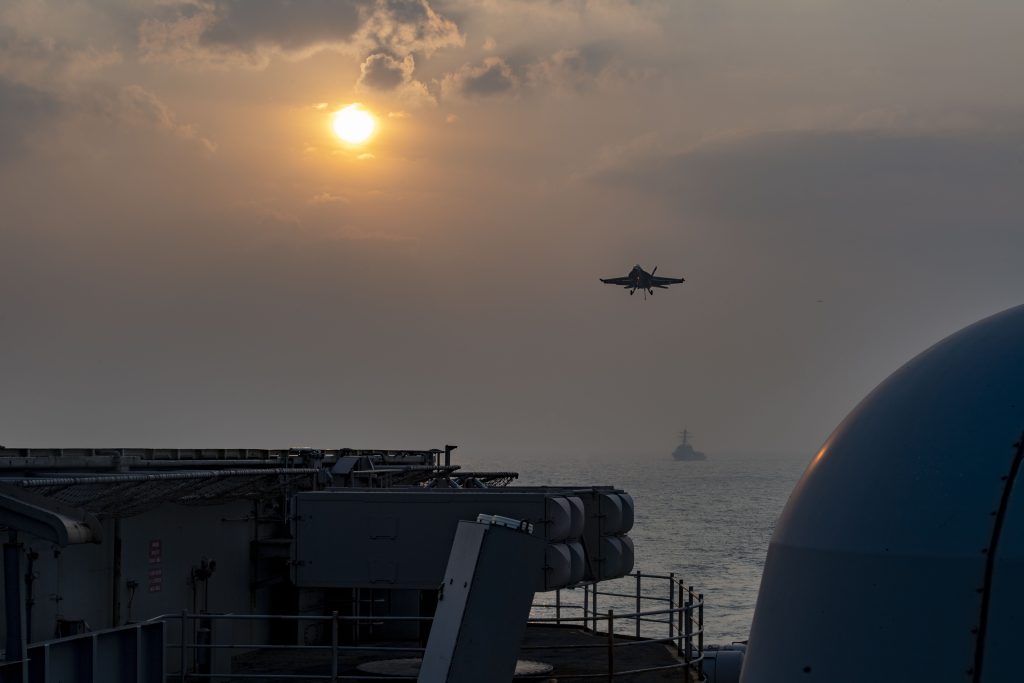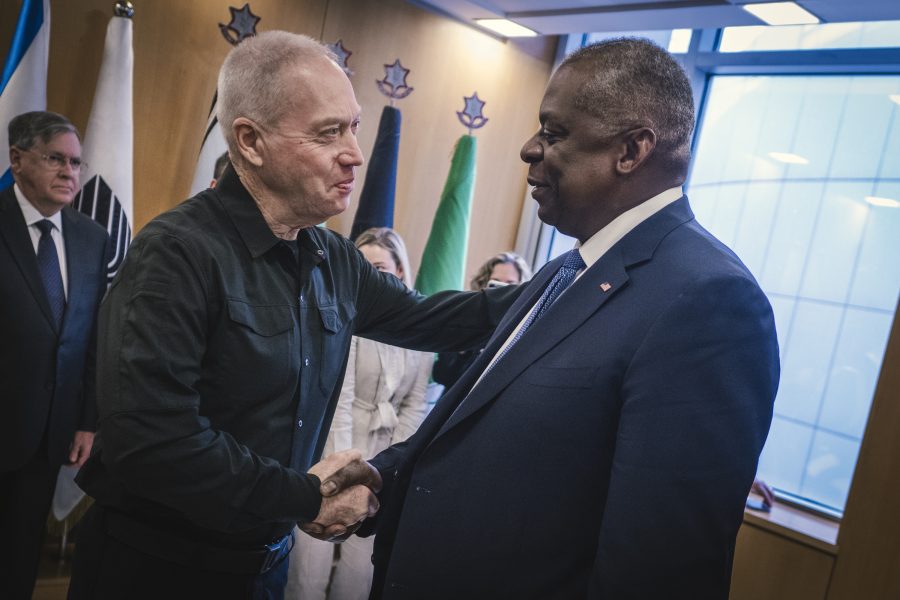The U.S. is establishing a multinational maritime task force—Operation Prosperity Guardian—to address attacks from Houthis in Yemen on commercial ships and other targets as the conflict in the Middle East widens and risks upending global trade, Secretary of Defense Lloyd J. Austin III announced Dec. 18. The Pentagon said Dec. 19 that the Houthis have conducted over 100 drone and ballistic missile attacks, targeting 10 merchant vessels involving more than 35 different nations.
“The recent escalation in reckless Houthi attacks originating from Yemen threatens the free flow of commerce, endangers innocent mariners, and violates international law,” Austin said in a statement Oct. 18 issued while he was on a trip to the Middle East. “Operation Prosperity Guardian is bringing together multiple countries to include the United Kingdom, Bahrain, Canada, France, Italy, Netherlands, Norway, Seychelles, and Spain, to jointly address security challenges in the southern Red Sea and the Gulf of Aden, with the goal of ensuring freedom of navigation for all countries and bolstering regional security and prosperity.”
So far, the nations haven’t revealed what the maritime task force will consist of, such as ships each country will contribute. Some nations, such as the U.K. and France, have already engaged Houthi drones during the recent crisis and have bolstered their maritime presence in the region.
Austin held a virtual meeting of top defense leaders with 43 countries as well as representatives from the European Union and NATO on Dec. 19, the Pentagon said.
“Secretary Austin condemned Houthi attacks on international shipping and global commerce as unprecedented,” according to a readout of the meeting provided by Pentagon Press Secretary Air Force Maj. Gen. Patrick S. Ryder.
The Pentagon said Austin, senior DOD leadership, CENTCOM commander Army Gen. Michael “Erik” Kurilla, and Naval Forces Central (NAVCENT) commander Vice Adm. Brad Cooper briefed participants on the roughly 100 attacks and noted the 25 crew of the merchant vessel Galaxy Leader are still being held hostage after Houthis seized the ship on Nov. 19.
“We’re taking action to build an international coalition to address this threat,” Austin told reporters Dec. 18. “This is not just a U.S. issue. This is an international problem, and it deserves an international response.”
During the meeting on Dec. 19, Austin urged more nations to join the maritime efforts to stop Houthi attacks.
Around the time Austin touched down in Israel on Dec. 18, the tanker M/V Swan Atlantic was attacked, and the USS Carney guided missile destroyer was dispatched to render aid, a U.S. military official said, highlighting how acute the Houthi threat has become. U.S. Central Command later said the bulk cargo ship M/V Clara had an “explosion in the water near their location” time. CENTCOM called both incidents “Houthi militant attacks.”
Austin arrived in Israel via Bahrain, home of U.S. naval forces in the region as part of the Navy’s 5th Fleet. Austin and Gallant discussed “the growing global threat posed by Houthis,” the Israeli defense chief said.
“They’re a terrorist organization,” Gallant said. “Their action[s] threaten international freedom of navigation and reckless behavior—firing ballistic, cruise missiles, and drones against Israel can drag the region into war.”
The Biden administration has not said whether it is prepared to use force to try to deter further Houthi attacks. When Biden was vice president during the Obama administration in 2016, a U.S. warship fired Tomahawk cruise missiles at three radar Houthi radar sites after they fired at the U.S. Navy and commercial ships in the Bab el-Mandeb Strait.

“The Bab el-Mandeb is incredibly important,” retired Army Gen. Joseph L. Votel, who commanded CENTCOM at the time, previously told Air & Space Forces Magazine.
“You could take action against coastal radars, coastal gun systems, missile systems, those kinds of sites,” Votel said of possible U.S. strike options.
The Houthis attacks are disrupting global trade, as traffic headed to and from the Suez Canal must pass the Bab el-Mandeb chokepoint near Yemen between the Red Sea and the Gulf of Aden.
“We’re going make sure that we’re doing everything that we can to ensure freedom of navigation in the area,” Austin told reporters. “The Strait is pretty important.”
The USS Dwight D. Eisenhower carrier strike group is near the Gulf of Aden off the coast of Yemen, satellite imagery shows. The Eisenhower’s position shows how quickly the Iranian-backed Houthis have changed America’s calculus. In November, the Eisenhower Carrier Strike Group arrived at the Persian Gulf to deter Iran and fly missions as part of the anti-ISIS campaign in Iraq and Syria. Now the Ike has returned to the coast of Yemen to deter the Houthis.

The Pentagon rushed F-35 Lighting II stealth fighters to the region to deter Iranian attacks on shipping, and the aircraft were also used over Syria. The F-35s left roughly a week before Hamas’ Oct. 7 attack on Israel, though the Air Force fighter posture in the region initially doubled to six squadrons after the Hamas attack.
The Ike could be called upon to provide airpower in support of military operations. Intelligence, surveillance, and reconnaissance assets such as MQ-9 drones and P-8 Poseidon maritime surveillance aircraft are among the aerial platforms that could assist military efforts against the Houthis if officials decide to use force. A U.S. Air Force MQ-9 was shot down off the coast of Yemen and fell into the Red Sea last month.
“The Red Sea is a critical waterway that has been essential to freedom of navigation and a major commercial corridor that facilitates international trade,” Austin stated in the Dec. 18 announcement of Operation Prosperity Guardian. “Countries that seek to uphold the foundational principle of freedom of navigation must come together to tackle the challenge posed by this non-state actor launching ballistic missiles and uncrewed aerial vehicles (UAVs) at merchant vessels from many nations lawfully transiting international waters.”
Experts and some U.S. officials say it is unclear whether the Houthis are acting on their own with Iranian-supplied weapons or are being directed to attack by Tehran—perhaps even with the benefit of Iranian intelligence agencies, some experts note.
The Behshad, which Iran says is a cargo ship, is widely believed to have intelligence-gathering capabilities. It has been in the Red Sea for years, replacing a vessel called the Saviz, which was attacked under mysterious circumstances.
On Dec. 19, Austin “reiterated that the international community is faced with an unprecedented global challenge that demands collective action,” the Pentagon said.
Editor’s Note: This story was updated on Dec. 19 after the virtual meeting on Red Sea attacks.


